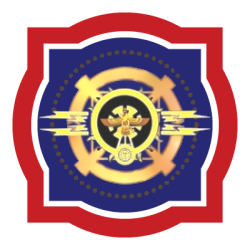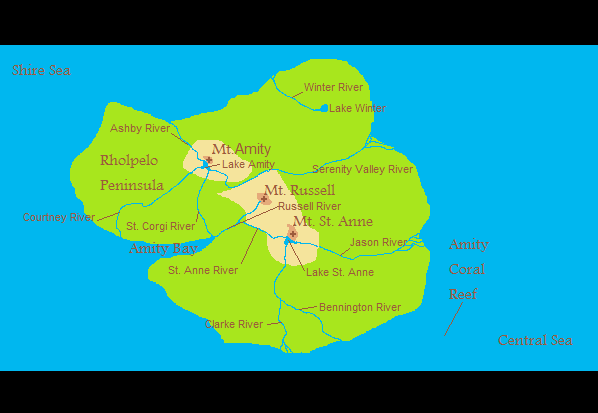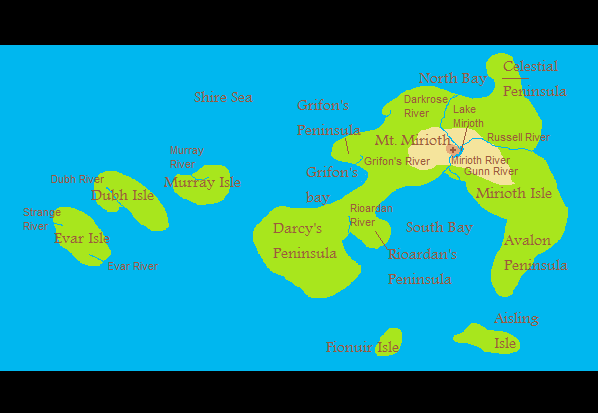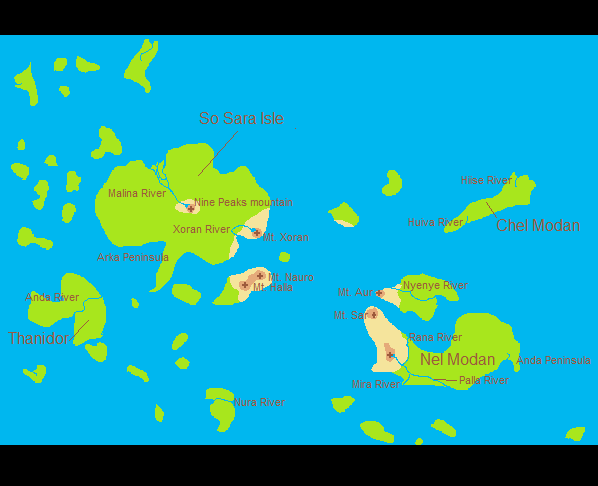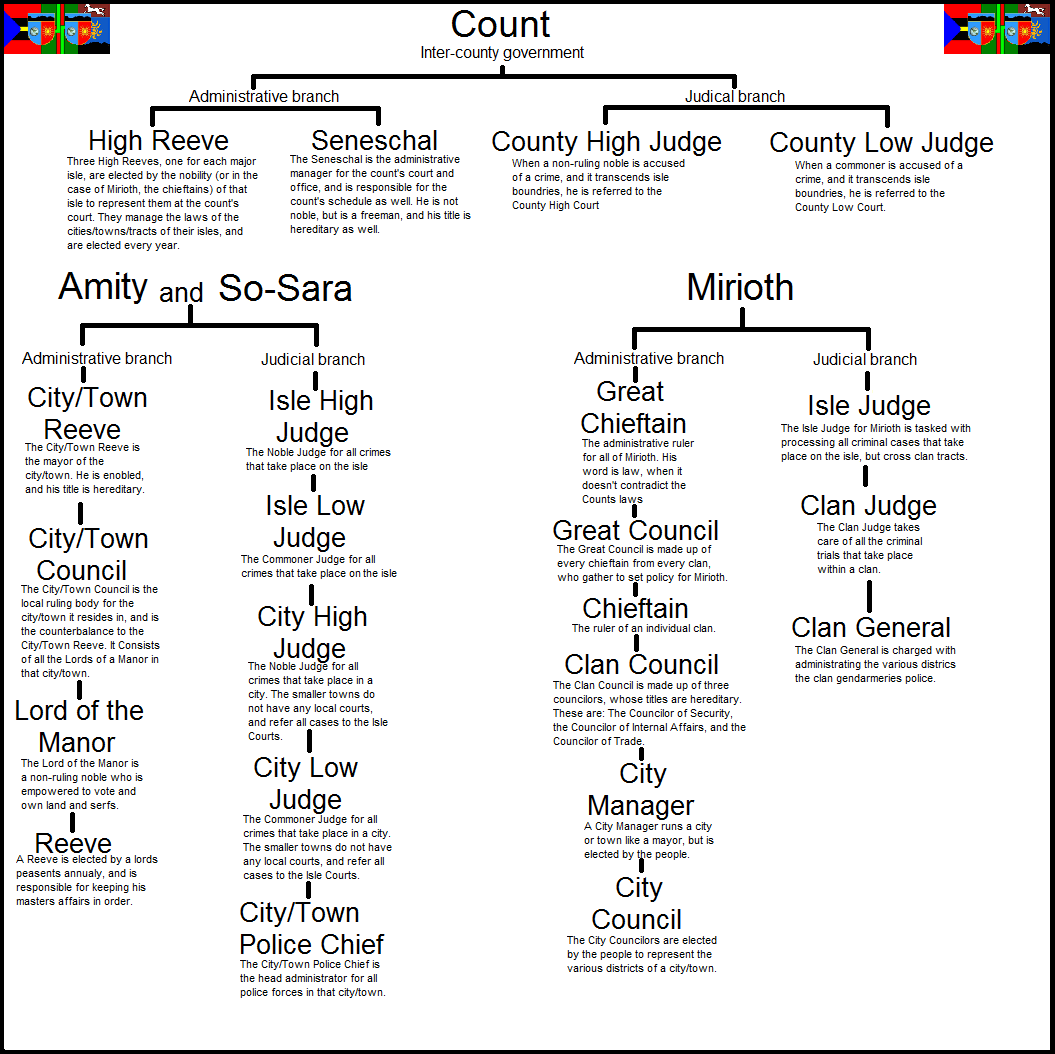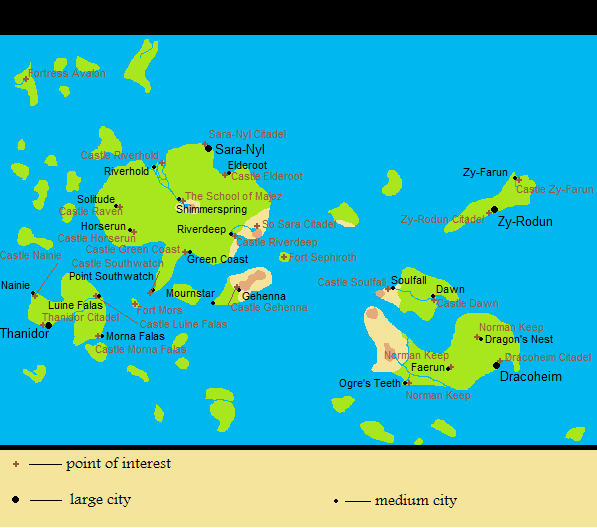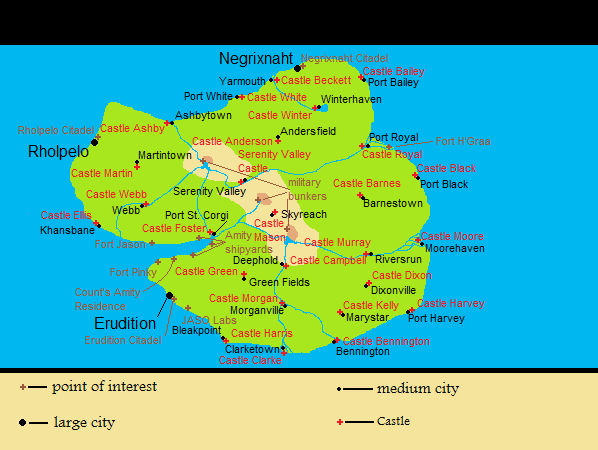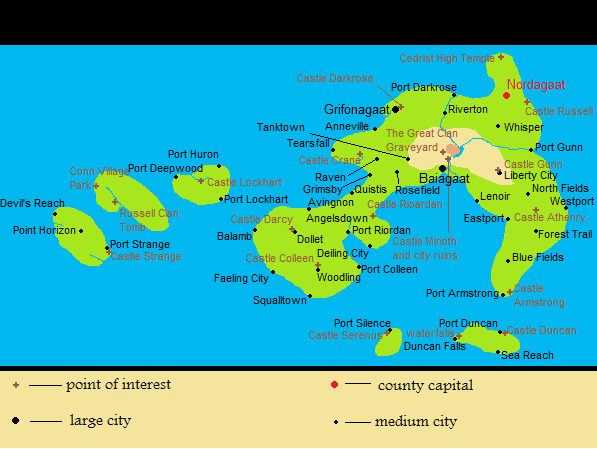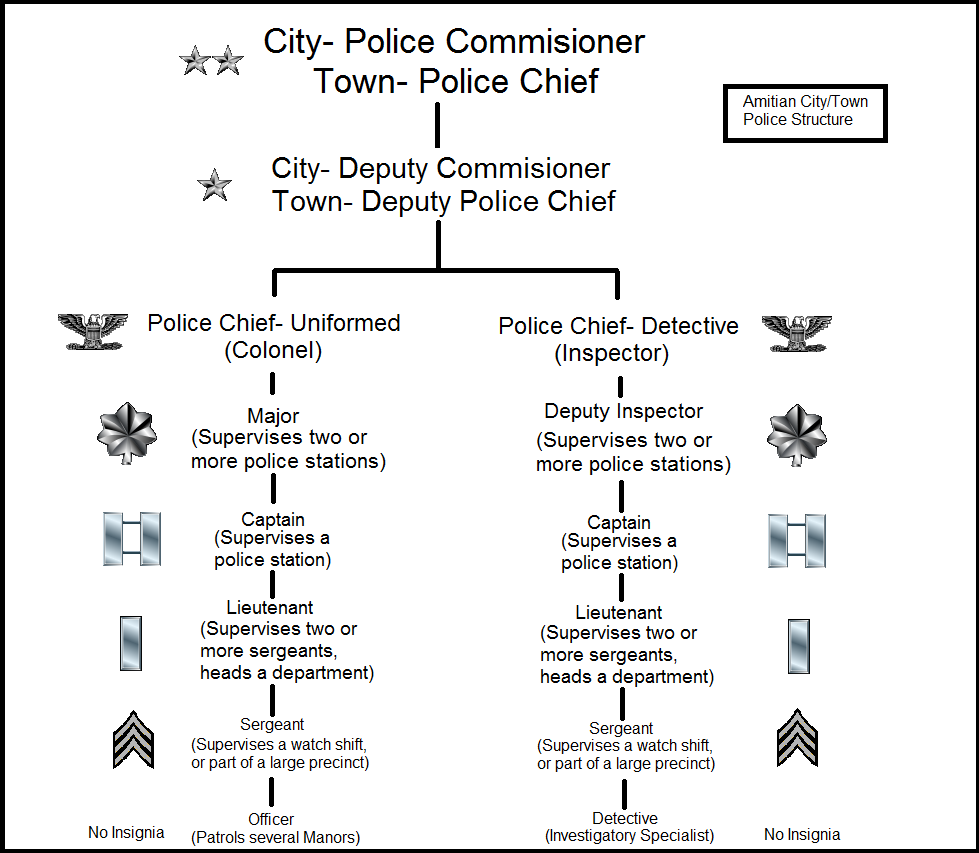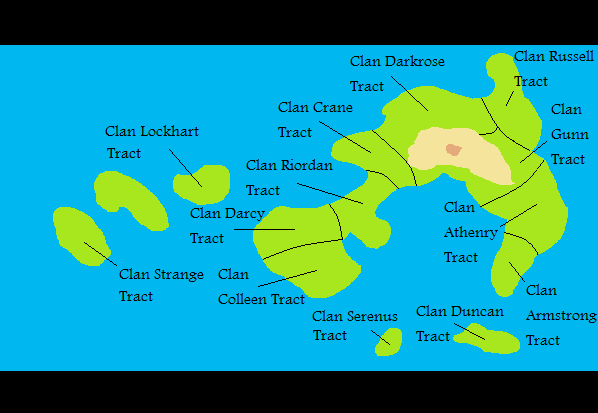Mirioth, Amity, and So-Sara
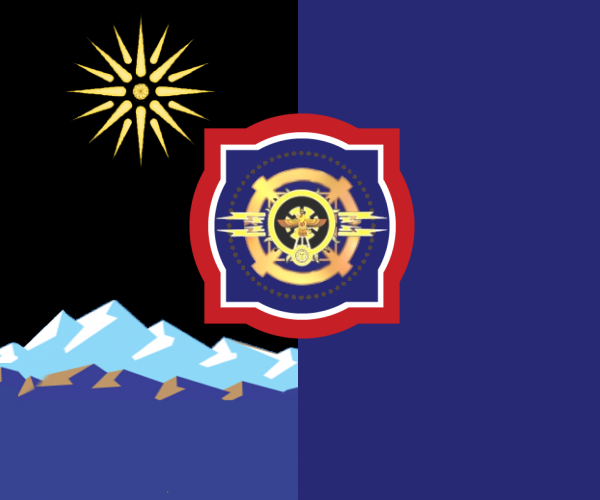
|
|
| Feudal Status: | County |
| Motto: | {{{motto}}} |
| Capital: | Nordagaat (Northgate) |
| Largest Cities: | Erudition, Nordagaat, Grifonagaat (Gryphon's Gate) |
|
| |
| Local Leadership Title: | Emir(a) |
| Local Government: | |
| Current leader: | Isabella Simrani-Kalirion |
|
| |
| Local language: | Babkhi, Yardistani |
| Local Religion: | Zurvanism, Cedrism |
The County of Amity, Mirioth and So-Sara (Popularly and historically the County of Mirioth, Amity, and So-Sara or County MASS for short) is an Emirate that spans over a large archipelago with five major islands and dozens of smaller islands. Being only a few hundred miles from the equator of Micras, it has a monsoonal, tropical climate, with jungles and mountains in the interior of the islands and beautiful beaches and craggy cliffs on the edges of the islands. Each of the five main islands have a dormant or extinct volcano on it as well, which have not erupted in thousands of years.
With the Yardistani archipelago's history stretching back to antiquity, the modern County of MASS formed only a scant 10 years ago, when the County of Amity and Mirioth annexed the county of So-Sara into its fold. Having been promoted and demoted several times in the feudal structure of Shireroth, it has been a county, a barony, and even briefly a duchy. It is considered a holy land for the Cedrists, and contains the Cedrist Temple north of Nordagaat on Mirioth, as well as the enigmatic and creepy Children of Mors.
Geography and Environment
The geography and environment of Mirioth, Amity, and So-Sara is roughly the same as described above, with a few notable differences.
Amity
Amity Isle has a square mileage of 78,122 miles, which makes it the third largest island in the Yardistani chain, right behind Florencia (1st) and Yardistan Proper (2nd). It has a tropical, monsoonal climate, which traditionally gives it two seasons in the year, the dry and the wet seasons. Amity receives anywhere between 70-240 inches of rainfall a year depending on your elevation, and relies heavily on its monsoons to maintain its cash crops. It is bordered by the Shire Sea to the north and west, and the Central Sea to the east and south. Though it has high foothills, they don't technically reach high enough to count as true mountains. Nevertheless, many of the 'peaks' have been named as mountains by the locals. Some of these include Mt. Amity, Mt. Russell, and Mt. St. Anne. It has one peninsula on the northwest tip of the island, named Rholpelo peninsula. On the southern tip of Rholpelo peninsula lies Amity Bay, a natural harbor with many fine beaches, harbors, and shipyards. To the southeast of Amity lies a rather large, crescent shaped coral reef that contains more than a hundred species of marine life. It is protected by the county as a countal treasure, and has long been considered by the locals to be a magical, sacred place. Nevertheless, many shipwrecks can be found there as well, as many a foolhardy captain tried unsuccessfully to navigate it.
Mirioth
Mirioth Isle has a square mileage of 33,236 miles, which makes it the seventh largest island in the Yardistani chain. It also has a tropical, monsoonal climate, and receives anywhere between 70-200 inches of rainfall a year. It is completely bordered by the Shire Sea, and its closest neighbor is Amity Isle to the southeast, about six-hundred miles away. Mirioth has three bays, the North Bay, the South Bay, and Grifon's Bay to the east. The South Bay is by far the biggest, and contains many smaller coves in it. It also has a large foothills region that leads to a single mountain (that is also not truly a mountain), named Mt. Mirioth. Mirioth also has five smaller islands that surround it. Dubh, Evar, and Murray Isle to the west, and Aisling and Fionúir isles to the south.
So-Sara
The Khaz Modanian archipelago has three main isles, thirty medium-sized isles, and over two-hundred smaller isles that surround them. With a total square mileage of 38,512 miles, the main islands of So-Sara, Nel Modan, and Chel Modan occupy the fifth, sixth, and eighth largest isle positions respectively. So-Sara has a subtropical climate, and tends to get closer to the traditional four seasons than its neighbors in Amity and Mirioth. It also has a strange, unique landscape that doesn't follow traditional island landscaping rules. Most islands tend to have low beaches that surround the island that gradually reach up to a volcanic peak, but the three main islands don't follow this. Southern So-Sara, eastern Chel Modan, and northern Nel Modan are all high above sea-level, with the land slowly declining as they reach outward, leading many to believe that it was one island at some point in history.
History
Government
Mirioth, Amity, and So-Sara is a feudal county ruled by a count, who is answerable to a baron, who is in turn answerable to a Duke, who is then answerable to the Kaiser. Below the count though, each island is ruled in different ways, which reflects the different cultures and histories of each island. The count is assisted by three High Reeves and a Seneschal, who ease the workload for their master (see chart below).
Amity
Amity is broken down into city and town limits, and then into smaller districts called 'manors'. City limits constitute any urban area with a population greater than 200,000, whereas town limits are any urban or rural area with a population less than 200,000. Each city and town is ruled by a City/Town Reeve, which is a hereditary position. His rule over the city/town is only absolute when he is not overruled by the city/town council, which consists of all the local lords (Amity peasants are not allowed to hold any government position higher than their specific manor).
Mirioth
Mirioth is ruled directly by The Great Council of the Clans of Alejia, which is presided over by the count (the Great Chieftain doesn't always have to be the count, but since the count is considered to be the ultimate authority in the county, it's useless to have anyone else in that position.). Each Great Councilor is a chieftain from his clan, and together they set policy for the whole of Mirioth. Each clan was given a set amount of land, called a Tract, and that Tract is ruled over by its own Clan Council, and the leader that presides over the Clan Council is called the Chieftain, which is a hereditary title as well. Each Clan Council has three positions that are also hereditary. The Councilor of Security rules over the Clan Gendarmerie, which acts as a combination police/militia. The second councilor is charged with all matters of internal affairs. Public health, learning, and infrastructure all fall under his jurisdiction, which means that all hospitals, schools, and public works facilities call him boss. The third councilor rules over trade, and acts as the treasurer for the clan. Each councilor has several sub-councilors that help in his duties. Sub-councilor is not a hereditary job. Miriothan life is much more free than the traditional feudal life in other counties. So long as you are not a nobleman (Great Chieftain, Chieftain, Great Councilor, Councilor, or any of their offspring or significant other), you were free to take whatever job you wanted (so long as it stays in-clan).
So-Sara
So-Sara is at a crossroads. It has had a fairly straight-forward feudal structure (exactly the same as Amity) that has changed little over time. With its modernization at the inclusion into MASS, social turmoil has started to turn into barely-suppressed rebellion. Only time will tell what happens next.
Military
Economy
Science and Technology
Mirioth, Amity, and So-Sara are not the leaders in technology (not like Brookshire or Straylight), but do have a rich history in high technology, mostly stemming from Amity's past as a Jasonian province. The JASO labs are located on Amity, and many old relics and examples of that heritage can be seen on display at several museums across Erudition. Due to its monopoly on gemstones, MASS does import a large number of technologies from the mainland, though.
Mining
Mirioth is known far and wide for its remarkable gemstones. No other Shirerithian province mines gemstones to the degree that Mirioth does, and as a result of this, the Clans of Alejia are able to command enviable prices for their shiny rocks. Popular exports include diamonds, rubies, sapphires, opals, and emeralds.
Farming
Farming accounts for a large portion of MASS's income (along with fishing and mining). Amity is nicknamed, "The tropical food-basket of Shireroth" for its extensive, sprawling plantations, farms, and orchards. Their main cash crops are mangoes and cotton, but most any other tropical plant is also grown in Amity to some extent. Examples include: Chili Peppers, bananas, vanilla plants, watermelons, coconuts, coffee, corn, and rice.
Mirioth has small to medium scale farming all over the island, but produce no where near the yield Amity and So-Sara have, and mostly use it for local consumption.
So-Sara has rich and extensive farms as well. Though they are not as focused on Cotton, they make up for it with mangoes, Lychees, grapes, oranges, lemons, Avocados, peanuts, and figs.
Fishing
There is a thriving fishing industry in County MASS on all three islands, and fish make up most of the meat MASS citizens eat.
Transportation
County MASS makes extensive use of its state-owned mass transportation networks, with fully 68% of its citizens making daily use of some form of mass transit (most of the citizens who don't use mass transit reside in So-Sara). Amity and Mirioth are the most advanced in this regard, with So-Sara only now starting to catch up with its neighbors to the southeast.
Rapid transit subways and elevated railways connect the major city districts (along with buses), with dedicated high-speed railways connecting the cities and towns to each other. Ferries connect the islands with each other as well, and since most ferries and trains are cheaper than importing cars (and the gas that follows), most people make good use of the cheap tickets that are subsidized by the government.
Cars are discouraged for private use, since importing gas is pricey, but rural or rich citizens still make use of cars. Short-haul tractor-trailers are still used to connect warehouses to the freight trains as well.
Cargo ships are also a very common sight throughout MASS.
Bicycles are also used frequently.
Each major city has an international airport that serves the public day and night, but are only used by businessmen and tourists who will travel over long distances. If traveling from isle to isle, the ferry is still the most popular (and cost-effective) method.
Public Utilities
Geothermal power plants provide all the electricity generation on Amity, and 60% of the energy generation on Mirioth, with the rest of the energy being provided by two nuclear power plants, which are scheduled for decommissioning as soon as the rest of the geothermal and solar power plants are brought online. So-Sara is, once again, behind Amity and Mirioth in renewable energy, and a motley assortment of coal, gas, and oil power plants are still used to generate 87% of the archipelago's energy. The remaining 13% is generated by solar and wind energy, with numerous geothermal power plants in production.
Fresh water is taken mostly from groundwater, but there are several desalinization plants that make up for the shortfall.
Before discovering the harmful effects of modern day pollution, most of the old sewers drained directly into the ocean. Now, the sewers drain into sewage treatment plants.
Demographics
Population
The population of County MASS is varied, and usually varies by island in skin tone, hair color, eye color, and height. 53% of County MASS are peasants (which in County MASS means they do not own land, which excludes them from voting in certain elections, or holding certain titles and jobs), 35% of the population are governed by a clan or a tribal system, which includes the Alejian Clans, the Thanidoran Tribes, and the Elvish Tribes (this means there are no peasants or noblemen in their territory, and that all land is owned collectively). The remaining 12% are the land-holding nobles, who in addition to the privilege of owning their land, may vote in certain elections, hold certain jobs that are off-limits to peasants, and rule their land with any laws or customs that do not violate a higher law.
So-Sara
So-Sara contains fifteen million citizens, with widely different features. The So-Saranin are generally a fair-haired race, while the people of the Burning Blade Clan are usually possessed of dark hair while maintaining light skin. The Thanidoran's have a darker skin tone to them, with the elves running the gamut in skin and hair color. The racial makeup is as follows:
- So'saranin- 27%
- Burning Blade Clan- 24%
- Thanidoran- 20%
- Elves- 17%
- Mixed*- 9%
- Other**- 3%
*'Mixed' indicates that zir citizen is descended from more than one race, or from any of the So'Saran races.
**There are numerous non-human, sentient creatures that also inhabit So-Sara, but are so great in variety and few in numbers (around 40 species), that the census office for County MASS decided to lump them all into the 'Other' category for ease of transcription.
Amity
Amity comes up second with ten million, whose racial makeup is as follows:
- Amitian- 32%
- Mixed*- 30%
- Jasonian- 27%
- Other**- 7%
Elves- 4%
* 'Mixed' indicates that zir citizen is of both Jasonian and Amitian in descent, with Amitian indicating a generally Yardistani heritage.
** 'Other' indicates that zir citizen is a non-elf, non-human citizen, or otherwise human and descended from elsewhere.
Mirioth
Mirioth has the smallest population, with only eight million citizens.
- Miriothan- 90%
- Elves- 7%
- Mixed*- 2%
- Other**- 1%
* 'Mixed' indicates that zir citizen is of both Miriothan and Elvish descent.
**'Other' indicates that zir citizen's heritage is from another ethnic group, or another species entirely.
Leading population centers
Rank, Island, Population, Metro Area Population
- 1. Erudition, Amity, 3 million, 7 million
- 2. Sara-Nyl, So-Sara, 2.5 million, 4 million
- 3. Thanidor, So-Sara, 2.2 million, 3 million
- 4. Dracoheim, So-Sara, 1.9 million, 5.5 million
- 5. Nordagaat, Mirioth, 1.7 million, 2 million
- 6. Baiagaat, Mirioth, 1.3 million, 3 million
- 7. Zy-Rodum, So-Sara, 900,313, 1.7 million
- 8. Grifonagaat, Mirioth, 872,301, 1.1 million
- 9. Rholpelo, Amity, 832,964, 1 million
- 10. Negrixnaht, Amity, 803,402, 902,947
Language
County MASS' official language is Yardistani, with Standard Shirerithian commonly taught as a second language where the local languages are not. It's also fairly common for many of MASS' citizens to speak more than two languages where a local language exists that is neither Yardistani or Shirerithian.
- Miriothan- 8 million
- Elvish- 5.5 million
- So'Saranin- 4 million
- Yardistani (only)- 3 million
- Thanidoran- 3 million
- Jasonian- 2 million
Religion
County MASS' official religion is Cedrism, with elements of Boomism usually bleeding into their ceremonies. It's rare to find a citizen who practices either religion exclusively. 70% of MASS citizens identify themselves as Cedrist, with a further 2% claiming pure Cedrism, and 7% claiming pure Boomism. 12% of MASS citizens claim the Elvish Naturalist religion, and 5% claim to practice the Thanidoran religion, with the remaining 4% claiming no religion or another foreign religion.
Education
Public Education in County MASS is regulated by the Duchy's Department of Education, which is headed by the Secretary of Education in Yardistan (SEY). The SEY is not a hereditary title, but must come from the nobility in Yardistan, and is appointed by each count as he sees fit. It is then broken down further on an island by island bases due to the widely different cultures. On Amity and So-Sara, preschool is not compulsory, but starting at age five, children are enrolled into kindergarten, then move on to Elementary school, which has five grades, and generally teaches children aged six to eleven. Next comes Middle School, which has three grades (6th, 7th, and 8th grade), and teaches children aged eleven to fourteen. Upon graduation from the 8th grade, serfs then receive a specialized education depending on what their lord plans to do with them. Rural lords often send their serfs to high schools with an emphasis on agriculture, forestry, or animal husbandry, while urban lords tend to lean towards high schools with an emphasis on manufacturing, retail/food service industry, or utilities. Serfs may attend college after graduation, but only with their lords permission, who may or may not force them to work full-time as well.
Children of nobility and children of aristocratic standing who are not ennobled (i.e. any child whose parents are lords of a manor, but not ennobled) attend separate schools, called 'academies', where they learn how to act as proper noblemen and landholders. As they graduate from their academies, they are required to attend a university (who do not allow peasants in), and at least get a bachelors degree.
Mirioth, as well as the Thanidoran and Elvish Tribes, are a bit different. Since they have a more tribal system, their education systems are usually separate from the So'Saran norm, or from Amity. Miriothan schools operate almost the same way as the traditional schools from elsewhere in County MASS, except all children attend the same local schools, regardless of economic or social status.
Elementary, middle, and high schools are funded by the county, and are free of charge. Commoner colleges as well as universities are not free, but are subsidized by the state to keep costs down.
Famous Universities include the University of Yardistan at Nordagaat (UYN), the University of Yardistan at Erudition (UYE), and the University of Yardistan at Sara-Nyl (UYS).
Health
County MASS's life expectancy is 78.2 years at birth, which is one year behind mainland Shireroth. Health care is universal in Yardistan, and is funded by taxation. It is rated 3rd in overall medical services by duchy, and 4th in response time. The average fertility rate for a woman from County MASS is 2 per woman. Because of the undead epidemic on Mirioth, all corpses on Mirioth are cremated for public health as well.
Crime and Law Enforcement
Law enforcement in County MASS is complicated, and is once again, broken down by island. In Amity and So-Sara, law enforcement is primarily the responsibility of the town/city, and then the Lord of the Manor. Each town/city has a civilian and dedicated police force composed of freemen from that town/city, who have jurisdiction over that whole town, regardless of what Manor they are currently in. Operating underneath the jurisdiction of the town police, are Manorial Police, who are free-landholders under contract to a specific lord who are trained at a police academy and then given back to their lords to police that particular manor. Manorial police usually operate on a part-time basis (with the rest of their time being given to a second job), and generally act as a first-responder to a situation in their manor, before town police can respond. All manors are required to have at least one Manorial Police Officer, and some large manors have more than one.
Mirioth uses a gendarmerie, which are operated on a clan-by-clan basis. They are trained and operated as if in a military, are considered military by law, but police civilians. They can double as a military force in the most extreme circumstances.
The Thanidoran and Elvish Tribes operate their own tribal police force on their lands as well.
The Noir are a secret police force that originated in Mirioth as a way to infiltrate and fight back against the Cult of the Descendi, but upon the incorporation of Mirioth into County MASS, they expanded their operations to Amity and So-Sara, and began working towards infiltrating and sabotaging other threats to the county. Membership is strictly regulated, and members are highly trained. For the safety of the agents, and the safety of their families, identities are never revealed. Operating in a sleeper cell fashion, agents are chosen from those who show interest in black-ops work (usually through unwitting conversation with an agent about it). Most Noir agents move on to SHINE, and some simply... disappear.
Because of the undead infestation of Mirioth, County MASS has some of the highest homicide and missing persons rates in the nation. It also has the highest concentration of terrorist and cult groups in all of Shireroth, which are listed below.
- The Cult of the Descendi: A cult who worship daemons, who are dedicated to bringing about their rule on Micras.
- The GHOST Program: A black-ops terrorist organization affiliated with the Immoti, the Mob, and the Elvish Tribes of Yardistan.
- The Storyville Vampyre Council: Officially classified as a terrorist organization, the Storyville Vampyre Council are a small group of humans and elves who are not truly vampires, but are nonetheless compelled to drink blood and avoid the sun because of a pseudo-magical, blood-transmitted virus.
- The Free Movement: The Free Movement is a terrorist organization with branches all over Shireroth, who are dedicated to bringing democracy to the land through force of arms. They worship the Kaiseress Aure I as their patron saint.
- The Beautiful Thieves: A thieves group operating throughout the isles, they are dedicated to stealing famous things that are considered beautiful, and then destroying them, thus making an 'art' statement about life.
- The Enlightened: A Secret Society outlawed by Yardistan, they practice magic and almost led to the destruction of County MASS three hundred years ago.
Court system and incarceration
Yardistan has its own court system, which it uses for local criminal cases. If any case cannot be concluded for any reason, it is deferred to the Imperial Judex, along with all appeals, and any criminal cases that transcend Ducal boundaries. The Count reserves the privilege to interfere in any court case that takes place on his lands.
All commoners (serfs and freemen) are tried by the Lesser Yardistani Courts, while the aristocracy and the lesser nobility are tried by the Greater Yardistani Courts. The greater nobility (i.e. those actively ruling) are always taken before the Imperial Judex, regardless of the crime.
Incarceration for commoners in County MASS takes the form of forced labor camps on Amity, where all prisoners who are serving a prison term of more than a month are taken. There they spend their evenings and nights in small prison camps, and during the day are taken to local plantation fields or to prison factories. Anyone who is convicted of double-homicide or greater automatically faces the death penalty, which takes the form of lethal injection.
Anyone convicted of raising the dead are shot... if they don't disappear before the trial.
Culture
County MASS is multicultural, feudal county that ultimately owes its allegiance to the kaiser of Shireroth. The culture of the county is split between Amity and So-Sara, which practice a straight-forward Manorialism, and Mirioth, which practices a clan system.
Manorialism in So-Sara and Amity
Amity and So-Sara are extremely divided by class. The lowest rung of society in MASS are the prisoners, which are exclusive to Amity. Once you have been arrested and convicted, you are sent to the Amity Prison System, where you serve your time in the fields or factories. These forced labor camps are watched over by hired prison guards, who are a mixture of freemen and serfs, and also watched over by prisoners with elevated status called “Keepers”. Keepers are prisoners who are given the responsibility of watching other prisoners, and are in exchange given reduced sentences and better living conditions. This system ensures that the keepers always side with the guards in a riot, gives the guards an extra hand in keeping order, and that a quarter of the prisoner population stays docile.
Once felons serve their sentence, they are sent before a parole board who determine if he has learned his lesson, and reformed his ways. If so, they are released back into the care of his lord, or if he came from Mirioth, then he is released back to his clan.
The next rung of the social ladder is the serf. Other countries find serfs to be disgraceful, the result of a social system woefully out of date. Serfs themselves find the system to be wonderfully safe. They never go hungry, they always have a job, never have to worry about homelessness, and they always have a guy (the lord) who is required by law to make sure their needs are met. When serfs go on vacation to places without feudalism or manorialism. They often come back with a hearty appreciation for their status, especially after encountering bums for the first time.
Serfs are tied to their lords for life, unless traded out or bought. They work for their lord in whatever business he has, and in exchange are clothed, fed, housed, and given a small amount of money. They must abide by the rules of the lord (who must abide by the laws of the land themselves), and must do as he says (within lawful reason). If they want to get married and have kids, the lord must pay a small fee to buy the serf from her previous lord.
After the serf, is the freeman. These are citizens of Yardistan who are beholden to no lord. They may come and go as they please, so long as they have the money and it does not violate any contract they are under. Some serfs have won their conditional freedom due to unusual circumstances, which means that they can quit working for their lord. This is a double-edged sword though, because it also means that they are no longer under his protection either.
Continuing up the ladder is the free-landholder. These are freemen who own their own land, but are not able to own serfs. The are not ennobled, but are not under any oath of fealty to a lord either. This social class is the smallest of all the classes.
Once a citizen has reached the status of a Lord or Lady, they have become a part of the lesser nobility, having received a Title of Nobility from the kaiser. They are now not only allowed, but required to own at least one manor. They may now vote in local elections, and may hold leadership positions in their town or county. Children of lesser nobility also retain that status, but may not live off the property of their parents until they themselves have a manor to rule (unless they live in a part of Shireroth or the world where manorialism doesn't hold sway, or are currently attending a boarding school or a university). Some never leave, simply living a rich life off their parents.
The Clans of Alejia
The Clans of Alejia are composed of thirteen different clans, each given a specific blessing and ban by Alejia. They have always resided on Mirioth Isle, and are known far and wide to be a stubborn and fiery lot.
- Name: Clan Athenry
- Nickname: “The Clan of Nature”
- Blessing: Affinity for nature
- Ban: Must not tolerate the undead.
- Info: Clan Athenry can turn a desert into a thriving woodland of plenty. It was this ability that allowed the Clans to reclaim Mirioth after Mt. Mirioth erupted. They are excellent farmers, but they also make strong warriors too, especially when the undead are involved.
- Name: Clan Armstrong
- Nickname: “The Clan of the Inner Fire”
- Blessing: strong willpower
- Ban: To not betray their clan
- Info: Clan Armstrong is known for its physical strength, and their activism in many controversial fields. More rebels with and without a cause come from this clan, then from any other clan. This passion for controversy often polarizes the Clan Council, and leads to a lot of bickering and infighting.
- Name: Clan Colleen
- Nickname: “The Gypsy Clan”
- Blessing: Illusion magic
- Ban: Cannot murder
- Info: Clan Colleen are the gypsy tricksters of Mirioth. Their shady exploits are legendary in County MASS.
- Name: Clan Crane
- Nickname: “The Workers Clan”
- Blessing: Superior physical strength and stamina
- Ban: Must not shirk your burdens
- Info: Clan Crane are the perfect workers. Strong and hardy, they could outwork any other clan hands down.
- Name: Clan Darcy
- Nickname: “The Clan of Darkness”
- Blessing: Natural Affinity for mundane knowledge
- Ban: Must use the knowledge for the benefit of the Alejian Clans
- Info: Clan Darcy are the counterparts to Clan Strange. While the Clan of Secrets work to uncover occult knowledge and defend the clans against it, The Clan of Darkness works to uncover and protect against the mundane secrets. They are the creators of the Noir, and are said to be very connected to SHINE.
- Name: Clan Darkrose
- Nickname: “The Clan of Destiny”
- Blessing: The power of prophecy
- Ban: cannot see their own future
- Info: The mark of someone from Clan Darkrose is the ability to tell the future in some way. Tea leaves, Octocluck entrails, tarot cards, dreams, omens in the stars, these are all different ways in which they can tell the future.
- Name: Clan Duncan
- Nickname: “The Clan of the Sea”
- Blessing: Affinity for the Sea
- Ban: No Duncan may ever escape the calling of the sea.
- Info: No Duncan has ever drowned. Ever. They are the consummate men and women of the sea. They are also superior warriors on the sea. When a Duncan joins the Marine Corps
- Name: Clan Gunn
- Nickname: “The Fighting Clan”
- Blessing: Superior fighting ability
- Ban: never fight anyone who is not worthy
- Info: Clan Gunn are superior warriors in almost every way, and it comes naturally to them. Even the smallest Gunn can boast that they have bested those who should have easily bested them.
- Name: Clan Lockhart
- Nickname: “The Hunter Clan”
- Blessing: Superior stealth
- Ban: Do not steal
- Info: The “Hunter Clan” are renown for their affinity for the hunt. They often compete with the Hunters of the Stag. They make superior trackers and snipers in the Yardistani Marine Corps.
- Name: Clan Riordan
- Nickname: “The Blacksmith Clan”
- Blessing: Affinity for creation
- Ban: Must always put your heart into your work
- Info: Clan Riordan were the blacksmiths of Mirioth since the very beginning. With the advent of modern foundry technology, they expanded their role to more than just weapons and armor.
- Name: Clan Russell
- Nickname: “The High Clan”
- Blessing: Natural leadership
- Ban: Not to traffic with daemons
- Info: The Russell Clan have ruled Mirioth since the very beginning. They are known by reputation to be strong, natural leaders, but are also known to be haunted by daemons.
- Name: Clan Serenus
- Nickname: “The Clan of Serenity”
- Blessing: The ability to calm their surroundings
- Ban: To never lie
- Info: Clan Serenus have the ability to calm their surroundings. Indeed, their island is eerily serene to those who first come to visit. After a few hours though, it begins to calm their nerves, and soothe their pain. It might seem odd, that a Clan of Alejia would be known for being calm, but a closer examination reveals that it actually makes a lot of sense. Just because one is calm, does not mean they are not passionate about what they believe in, or furious about their calm. They are marked by their stark-white eyes.
- Name: Clan Strange
- Nickname: “The Clan of Secrets”
- Blessing: natural affinity for occult knowledge
- Ban: to not use occult knowledge for personal gain.
- Info: The Strange Clan are known for their eccentric behavior.
TV
Television in County MASS is the usual mix of everything, with the major stations broadcasting free of charge. Anyone with a set of 'rabbit ears' can tune in and be entertained. For a small fee, one can buy a 'cable box', which broadcasts over 200 stations. The most watched television show of County MASS is the eight-seasons-long fictional drama, 'Lords and Ladies', which tells the story of the aristocracy of Shireroth, and all the drama that ensues. The longest running comedy show has been, 'My name is Kaiser Mog', and tells the story of kaiser Mog and the ensuing rebellion in comedic fashion.
Film
The film industry in Yardistan grosses more than 5 billion erb a year worldwide. While this is not as great as their neighbors to the north, it brings a steady stream of money, as well as a rabid fan base, to Yardistan every year. The top grossing film of last year was, 'Starlight', a fantasy film about vampyres of Storyville.
Music
Music in County MASS ranges from modern rock and pop, to traditional music that has been here for thousands of years. One of the most beloved folk songs of Mirioth is entitled, 'Black Velveteen Band', which is a cautionary tale about men who get fooled by pretty women, then go to jail.
Literature
County MASS literature is broken down into six categories. The oldest category is the 'Ancient' classification. These are the earliest works of the islands, and go back to around b4205. Two of the most popular works are, “Moon and Star”, a story about tragic love, and “The Taming of a Mountain God”, a story about one heroes quest to destroy a tyrannical mountain god.
The next oldest category is the 'Classical' classification. These works date back to b2600, and vary in theme and length. The best example of 'Classical' literature is the story, “Star of the Sea”, a fictional story about a star which fell to the sea near Mirioth. Upon surfacing, the star assumes the body of a beautiful woman, and must struggle against gods and man to return to the heavens.
After Classical literature, comes 'Medieval' literature. These works date to around 100 ASC. Two excellent examples include “The Lord and Lady”, on which the television show is based off of, and “Dark Castle”, a re-telling of the tragic circumstances that led to the destruction of Mirioth City.
The Medieval literature classification gives way to the 'Renaissance' literature classification around 1000 ASC, and is generally 'enlightened' in tone. The best example of Renaissance literature is the book, “Musings on the Cedrist gods”, an autobiographical story of a Cedrist monk who gives up his faith for logic and reason.
Following the Renaissance literature era, came the 'Industrial' literature era. As the Renaissance era began to stumble and fail, many writers of the era became disillusioned with the new, 'enlightened' ideas when they failed to prevent the island's fall into pollution and crime. The greatest example of Industrial era literature is, “Twilight to Starlight”, a semi-autobiographical tale of one man's descent from enlightened renaissance thinking, into drugs, alcohol, and homelessness.
The gritty, dark tones of the Industrial era finally give way to the 'Modern' literature era. The best example of this is, “The War of the Shades”, a fictional tale of the battle between the Cult of the Descendi, and the Noir.
Philosophy
County MASS has the dubious honor of being the birthplace of the 'Enlightenment' (described in more detail elsewhere), which almost destroyed Yardistan. Other than that, they are known for their rebellious and contentious attitudes. They fight others, themselves, and the police don't even bother breaking up street fights most of the time.
The Arts
The Art scene is to die for in County MASS. No, literally. People have died for art in County MASS. From the filchers in the Beautiful Thieves, to independent artists who kill others over perceived slights, County MASS takes their art seriously. The history of art in County MASS follows the literary path described above, and is featured in museums the world over.
Food
Yardistani food is hot. Really Hot. The citizens of County MASS like their food spicy, and routinely heat up their food with levels of heat that outsiders consider crazy. Seafood is the specialty of the county as well, with the whole of Yardistan accounting for half of Shireroth's seafood consumption.
Sports
Soccer is the most popular sport in County MASS by far, with rivalries regularly leading to riots and bar fights. Other sports practiced to a lesser extent are Baseball, roller derby, and boxing.
Appendix
When dealing with Amity in any story, keep in mind that it should be given a Pre-civil war American South meets the American 'Roaring 20's meets English gentry feel. Mirioth should be given a Scots/Irish culture meets 'roaring 20's feel. So-Sara should feel likes its Lord of the Rings meets modern technology.
